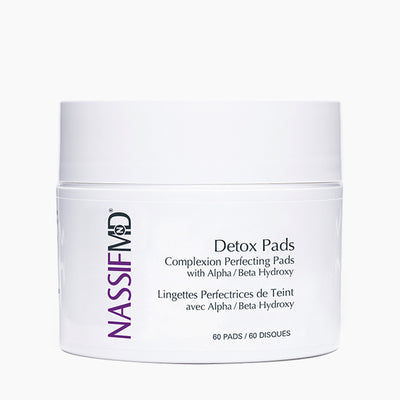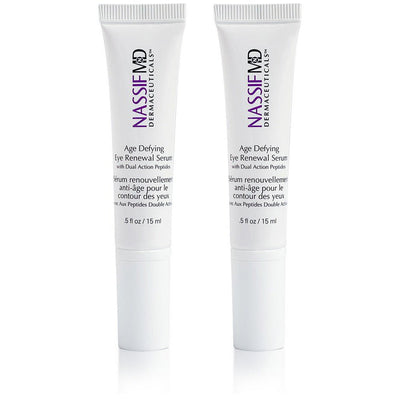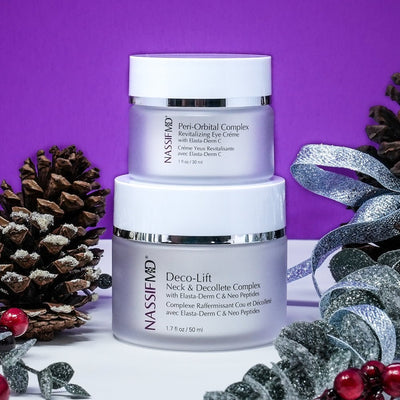What Skincare Ingredients Pair Best with Peptides?
Peptides are the must-have skincare ingredient for healthy, younger skin. Peptides in skincare are not new; they are becoming more widespread but may not consistently deliver the best results. Why? Because peptides work best in synergy with other active ingredients.
NassifMD® facial plastic surgeon skincare understands what the skin needs and how ingredients work together to deliver results. Throughout the NassifMD® Skincare line, we harness the power of bioactive compounds working together in the skin.
Today’s article will dive into peptides skincare and the ingredients to include in your routine alongside peptides. Keep reading as we explore:
- What are peptides?
- Skincare ingredients to enhance the benefits of peptides
- The best peptide serum and other peptide products from NassifMD® Skincare
Ingredients that Enhance Peptide Benefits
Before we discuss the skincare ingredients that enhance peptides, let’s start with what a peptide is. A peptide or polypeptide is a small protein molecule added to skincare products to mimic the natural peptides the skin makes. These peptides stimulate collagen production and address aging concerns such as fine lines, discoloration, and inflammation. They help improve the skin barrier, supporting skin health and hydration.
Are peptides safe? Peptide side effects are rare because they are natural molecules the skin and immune system recognize. Still, you can always patch-test new products for tolerance, especially if you have sensitive skin.
Learn more about peptides in skincare by reading:
One of the little-known skincare secrets is to combine skincare peptides with other active ingredients for synergistic benefits. Now, let’s explore these ingredients.
Vitamin C
Topical vitamin C is a powerful antioxidant, a cofactor for collagen production, and a brightening agent known for fading areas of hyperpigmentation. Where peptides stimulate the collagen production, cells require vitamin C for the actual chemical reaction. Using them together is recommended to enhance the skin’s structure and appearance.
Retinol
Retinol is another anti-aging skincare ingredient to use with peptide serum and other peptide skincare products. Retinol is an active vitamin A used topically for its anti-wrinkle benefits. It’s been shown to minimize fine lines and wrinkles, address hyperpigmentation, improve skin tone and texture, regulate oil production, and promote collagen formation. With many of the same benefits as peptides, each ingredient enhances the other.
Hyaluronic Acid
Use hyaluronic acid and peptides for skin for enhanced benefits. Hyaluronic acid is a natural molecule found in the body. When applied topically, it helps pull moisture into the skin and hold it there, making it one of the most hydrating and anti-aging ingredients. You’ll find it throughout the NassifMD® Skincare line.
Niacinamide
Niacinamide is a form of vitamin B3, a critical antioxidant and involved in cellular metabolism. As a topical skincare ingredient, niacinamide improves facial aging, elasticity, and appearance. You’ll find niacinamide along with peptides in peptide cream and other products, or you can use it in a different step in your skincare routine for the same synergistic benefits.
Ingredients that Boost Peptide Penetration
Using vitamin C, retinol, hyaluronic acid, and niacinamide in your skincare routine will enhance the benefits of anti-aging peptides and peptide serums. Next, we’ll discuss hydroxy acids and how they allow for increased absorption and penetration of peptides and the other active ingredients you apply.
Glycolic Acid
Glycolic acid is a natural alpha hydroxy acid, a chemical exfoliant in skincare. As one of the smallest hydroxy acids, glycolic acid has many uses in skincare and dermatology. It penetrates the skin, cleans out pores, and allows dead skin cells and impurities to wash away. Exfoliating prior to using peptide products enables the peptide serum to penetrate deeply for improved results.
Salicylic Acid
Salicylic acid falls into the category of beta hydroxy acids. Like glycolic acid, it’s a chemical exfoliant in various exfoliating products. Exfoliation helps to minimize fine lines, improve firmness, increase hydration, and balance the skin. Exfoliating as part of your skincare routine also allows other skincare ingredients, including peptides, to have better penetration and work better.
Lactic Acid
Lactic acid is another example of an alpha hydroxy acid chemical exfoliant (mandelic acid and phytic acid are others). Even the best peptides won’t work well if they can’t get into the skin. Dead skin cells, dirt, and other impurities collect in pores and on the skin’s surface; exfoliation removes them, allowing skincare products to penetrate and do their job.
Antioxidant Ingredients to Pair with Peptides
We’ve already covered a few ingredients with antioxidant activities, including vitamin C, retinol, and niacinamide, that enhance peptide benefits. Let’s add a couple more to the list: ferulic acid and resveratrol.
Ferulic Acid
Free radicals caused by UV radiation, pollution, and even normal metabolism can disrupt skin health and accelerate aging. Plants are a significant source of antioxidants and support skin health by protecting skin cells from free radical damage.
Ferulic acid is a common skincare ingredient (a phenolic plant extract) with a high affinity to neutralize free radicals. It’s often used in conjunction with other skincare ingredients, including peptides, for synergistic effects and enhanced cellular protection.
Resveratrol
Resveratrol is another polyphenol plant antioxidant found in red grapes, peanuts, and red wine. As a skincare ingredient, resveratrol has the potential to support dermatological conditions and skin aging. Topical preparations are well tolerated and synergistically work with other active ingredients, including skincare peptides.
Moisturizing Ingredients to Pair with Peptides
We’ve covered skin nutrients, hydroxy acids, and antioxidants, and peptides work with all of them! They also work with moisturizing ingredients that support skin barrier health, including ceramides and squalane.
Ceramides
Ceramides are natural lipid molecules that make up the skin barrier, allowing the skin to say hydrated by preventing water loss. The lipid skin barrier also provides protection from the sun, pollution, and other damaging molecules. Using ceramides along with peptides helps lock the peptides (and their health benefits) in the skin.
Squalene
Like ceramides, squalene is a surface lipid found in the skin that helps support skin health and barrier function. When using a peptide face cream or other skincare products with active ingredients, squalene enhances the benefits and strengthens the outermost layer of the skin.
Now that it’s clear how and why you need other skincare ingredients along with peptides let’s walk through how to get the most benefits from a simple skincare routine that includes anti-aging peptides for skin health.
First, use an exfoliator with hydroxy acids. Exfoliation can be part of your daily cleansing or a step in your routine a few times weekly. Exfoliation sweeps away dead skin cells, revealing younger cells below. It also improves peptide penetration.
We recommend the best-selling NassifMD® Detox Facial Pads with salicylic acid, glycolic acid, and lactic acid.
Second, make NassifMD® Hydro-Screen a part of your daily routine. This best-selling serum contains several active ingredients to enhance skin health, hydration, rejuvenation, and peptide function. It contains hyaluronic acid, ceramides, retinol, and powerful plant antioxidants.
Finally, choose high-quality peptide products from NassifMD® facial plastic surgeon skincare to target skin health and collagen production and combine active ingredients. Popular peptide options include:
- NassifMD® Pro Peptide Collagen Serum with peptides, beta-glucan, and hyaluronic acid
- NassifMD® Deco-Lift Neck and Decollete Firming & Lifting Complex with peptides, vitamin C, and glycolic acid
- NassifMD® Crepe Inhibitor Triple Action Body Butter with peptides, shea butter, and plant antioxidants
- NassifMD® Age Defying Eye Renewal Serum with two peptide complexes, polysaccharides, and antioxidants
- NassifMD® Soft Focus Hydrating Day Cream with peptides, niacinamide, hyaluronic acid, and antioxidants
- NassifMD® Wrinkle Blur Targeted Treatment with peptides, vitamin C, hyaluronic acid, and antioxidants
- NassifMD® Age Defying Neck and Decollete Serum with peptides, niacinamide, and antioxidants
- NassifMD® Undereye Anti-Aging Smoother with peptides, polymer complex, and antioxidants
While it’s easy to think that peptides are the secret to healthy, radiant, younger-looking skin, the secret is really the combination of peptides with other nourishing, protective, and rejuvenating ingredients. Don’t just look for the latest peptide alone; use NassifMD® Skincare with synergistic active ingredients in every step of your skincare routine.
References
- Gorouhi, F., & Maibach, H. I. (2009). Role of topical peptides in preventing or treating aged skin. International journal of cosmetic science, 31(5), 327–345.
- Al-Niaimi, F., & Chiang, N. Y. Z. (2017). Topical Vitamin C and the Skin: Mechanisms of Action and Clinical Applications. The Journal of clinical and aesthetic dermatology, 10(7), 14–17.
- Zasada, M., & Budzisz, E. (2019). Retinoids: active molecules influencing skin structure formation in cosmetic and dermatological treatments. Postepy dermatologii i alergologii, 36(4), 392–397.
- Juncan, A. M., Moisă, D. G., Santini, A., Morgovan, C., Rus, L. L., Vonica-Țincu, A. L., & Loghin, F. (2021). Advantages of Hyaluronic Acid and Its Combination with Other Bioactive Ingredients in Cosmeceuticals. Molecules (Basel, Switzerland), 26(15), 4429.
- Bissett, D. L., Oblong, J. E., & Berge, C. A. (2005). Niacinamide: A B vitamin that improves aging facial skin appearance. Dermatologic surgery : official publication for American Society for Dermatologic Surgery [et al.], 31(7 Pt 2), 860–865.
- Michalak M. (2022). Plant-Derived Antioxidants: Significance in Skin Health and the Ageing Process. International journal of molecular sciences, 23(2), 585.
- Shu, P., Mo, J., Li, Z., Li, M., Zhu, W., & Du, Z. (2024). Ferulic acid in synergy with retinol alleviates oxidative injury of HaCaT cells during UVB-induced photoaging. Aging, 16(8), 7153–7173.
- Lin, M. H., Hung, C. F., Sung, H. C., Yang, S. C., Yu, H. P., & Fang, J. Y. (2021). The bioactivities of resveratrol and its naturally occurring derivatives on skin. Journal of food and drug analysis, 29(1), 15–38.
- Borodzicz, S., Rudnicka, L., Mirowska-Guzel, D., & Cudnoch-Jedrzejewska, A. (2016). The role of epidermal sphingolipids in dermatologic diseases. Lipids in health and disease, 15, 13.
- Paramasivan, K., & Mutturi, S. (2022). Recent advances in the microbial production of squalene. World journal of microbiology & biotechnology, 38(5), 91.



































